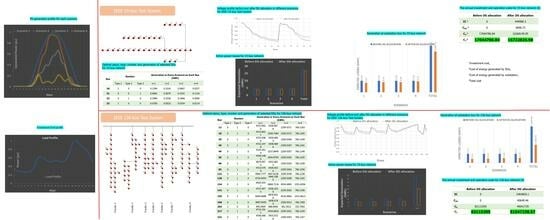Optimal Probabilistic Allocation of Photovoltaic Distributed Generation: Proposing a Scenario-Based Stochastic Programming Model
Abstract
:1. Introduction
1.1. Background
1.2. Literature Review
1.3. Contributions
- Optimal DG allocation: We underscore the paramount significance of optimal DG allocation within distribution networks. Our exploration involves identifying the optimal site (among grid nodes), type (from three classifications), and quantity (integer variable) of PV units as the problem’s decision factors for optimal DG allocation. Through our research, we illustrate the substantial potential for cost savings, encompassing both investment and operational expenses. This holistic approach directly addresses the imperative for efficient resource allocation in distribution networks.
- Effective uncertainty handling: Our research tackles the challenge of uncertainty management in DG allocation. We incorporate uncertainties such as load fluctuations and variable PV generation into our stochastic formulation. The DGA problem is formulated as a stochastic programming problem because of generation uncertainties (related to solar irradiation) and their occurrence likelihood. In stochastic formulation, varying load levels of the hour-by-hour load profile over the course of a day illustrate load variations. This aspect of our work enhances the practicality and reliability of DG deployment strategies.
- Holistic cost minimization: Our primary objective is to minimize the overall cost of distribution networks, encompassing not only energy generation costs but also the financial implications of DG units. This comprehensive approach offers valuable insights into cost reduction, reinforcing the practicality of DG integration.
- Sustainable energy initiatives: We advocate for DG unit integration as a means to bolster the sustainability of distribution networks. By generating power closer to load points, DG units effectively reduce network losses, contributing to a greener and more efficient energy distribution system. Our research aligns with global efforts to transition toward sustainable and resilient energy systems, emphasizing the practical steps required to achieve these objectives.
- Solver efficiency: We utilize the CPLEX solver within the AMPL framework to tackle the complex mixed-integer conic optimization problem inherent in our model. The decision-making procedure can be solved by adjusting the dynamic optimal power flow (DOPF) problem to the associated network as a MISOCP problem. This choice ensures the derivation of high-quality solutions, a crucial aspect for the practical implementation of optimal DG allocation strategies.
- Real-world validation: Our research undergoes rigorous validation, first on the IEEE 33-bus distribution system and, subsequently, on a real-world 136-bus distribution network in Três Lagoas, Brazil. This validation encompasses scenarios with and without DG units, addressing daily load variations and PV generation uncertainty.
2. Problem Formulation
3. Case Study and Its Results
3.1. Description
3.2. Results and Discussion
3.2.1. Results of 33-Bus Distribution Network
3.2.2. Results of 136-Bus Distribution Network
4. Conclusions and Future Works
4.1. Key Conclusions and Novelties
- Optimal DG allocation: The integration of DG units in distribution networks presents a complex interplay of investment and operational costs. Our research emphasizes the importance of optimal DG allocation. By determining suitable locations, types, and sizes for DG units within the distribution network, we demonstrate the potential for substantial cost savings, considering both investment and operational expenses.
- Effective handling of uncertainties: Incorporating uncertainties, such as load fluctuations and variable PV generation, into the allocation problem is crucial. Our stochastic formulation accounts for these uncertainties, making it a valuable tool for real-world applications.
- Holistic cost minimization: The primary objective of our research is to minimize the overall cost of the distribution network. This includes not only the cost of energy generation at the substation but also the financial outlays associated with DG units, thereby providing a holistic perspective on cost reduction.
- Sustainable energy futures: Our research advocates for the integration of DG units as a means to enhance the sustainability of distribution networks. By generating power closer to the load points, DG units effectively reduce network losses, thereby contributing to a greener and more efficient energy distribution system. This research aligns with global efforts to transition towards sustainable and resilient energy systems. It underscores the role of distribution networks in this transition and highlights the practical steps needed to achieve these goals.
- Solver efficiency: We employ the CPLEX solver within the AMPL framework for solving the complex mixed-integer conic optimization problem introduced by our model. This optimization technique ensures the derivation of high-quality solutions, which are imperative for the practical implementation of optimal DG allocation strategies.
- Real-world testing: The proposed model was initially applied to the IEEE 33-bus distribution system to evaluate its performance. To further validate its effectiveness, the model was then tested on a real-world 136-bus distribution network of Três Lagoas located in Brazil [33]. This validation encompassed scenarios both with and without DG units, under scenarios of daily load variations and PV generation uncertainty.
- Practical insights and transdisciplinary application: This work offers practical insights and guidance for energy engineers and policymakers tasked with optimizing distribution networks. It highlights the dual benefits of cost savings and enhanced network performance achievable through strategic DG deployment. The findings of our research hold relevance not only within the realm of electrical engineering but also in broader energy and infrastructure management contexts. The principles of optimal DG allocation and addressing uncertainties are applicable to diverse fields striving to optimize resource allocation under uncertain conditions.
4.2. Future Research Directions
- Incorporating demand-side response in DG allocation: Future studies should embrace the challenge of DG allocation while considering the dynamic aspect of demand-side response (DSR). This entails framing the problem as a mixed-integer conic stochastic programming problem, encompassing various forms of DG sources, such as wind and solar generating plants. DSR, characterized by end-user customers’ adjustments in electricity consumption patterns in response to price fluctuations or incentive payments, presents a novel facet of DG allocation. Essentially, DSR can be regarded as a dynamic component akin to virtual DGs or negative load, offering a fresh perspective on the DG allocation challenge.
- Exploring decision-dependent uncertainty: Endogenous uncertainty pertains to controllable factors influencing decision-making uncertainty. It encompasses variables such as price disclosure, business cycle, and the decision itself. Addressing it empowers decision makers to enhance strategies, manage risk, and optimize outcomes [34]. Decision-dependent uncertainty (DDU) represents a burgeoning area of research. DDU, intricately linked with the decision maker’s strategy, warrants further exploration and application in optimization problems. The existing literature has provided a foundation for understanding DDU [35], but future works should delve deeper into its nuances and implications within the context of DG allocation and distribution network optimization.
- Incorporating market price uncertainty: Future endeavors should aim to expand the horizons of uncertainty consideration by incorporating additional sources, such as market prices, into the model. This augmentation would enrich the decision-making capabilities of the model, allowing for a more holistic assessment of the problem within the dynamic context of fluctuating market conditions.
- Advanced solution techniques: The quest for enhanced computational efficiency in addressing larger instances of the problem prompts the exploration of advanced solution techniques. The linearization of optimization formulations, particularly within the realm of Benders decomposition alternating current optimal power flow (ACOPF), offers a fertile ground for future research [36]. By delving into the application of these techniques, researchers can strive to optimize the allocation of resources and expedite the decision-making process, thus accommodating the complexities of large-scale problems more effectively [20,37].
- Exploring extreme scenarios: In the pursuit of robustness and comprehensive modeling, future research should consider the incorporation of extreme scenarios. These scenarios, based on factors such as extreme climate conditions, can provide valuable insights into the resilience and adaptability of DG allocation models. By investigating how DG systems perform under the most challenging circumstances, we can gain a deeper understanding of their limitations and potential avenues for enhancement.
Author Contributions
Funding
Data Availability Statement
Conflicts of Interest
References
- Badran, O.; Mekhilef, S.; Mokhlis, H.; Dahalan, W. Optimal reconfiguration of distribution system connected with distributed generations: A review of different methodologies. Renew. Sustain. Energy Rev. 2017, 73, 854–867. [Google Scholar] [CrossRef]
- Mahdavi, M.; Kheirkhah, A.R.; Macedo, L.H.; Romero, R. A genetic algorithm for transmission network expansion planning considering line maintenance. In Proceedings of the 2020 IEEE Congress on Evolutionary Computation (CEC), Glasgow, UK, 19–24 July 2020; pp. 1–6. [Google Scholar]
- Rahmani-Andebili, M.; Fotuhi-Firuzabad, M. An adaptive approach for PEVs charging management and reconfiguration of electrical distribution system penetrated by renewables. IEEE Trans. Ind. Inform. 2017, 14, 2001–2010. [Google Scholar] [CrossRef]
- Kheirkhah, A.R.; Pozos, A.T.; Zandrazavi, S.F.; Franco, J.F.; Leite, J.B. A Stochastic Programming Model for the Optimal Allocation of Photovoltaic Distributed Generation in Electrical Distribution Systems Considering Load Variations and Generation Uncertainty. Simpósio Bras. De Sist. Elétricos-SBSE 2020, 1. [Google Scholar] [CrossRef]
- Poudel, S.; Dubey, A.; Bose, A. Risk-based probabilistic quantification of power distribution system operational resilience. IEEE Syst. J. 2019, 14, 3506–3517. [Google Scholar] [CrossRef]
- Sultana, B.; Mustafa, M.; Sultana, U.; Bhatti, A.R. Review on reliability improvement and power loss reduction in distribution system via network reconfiguration. Renew. Sustain. Energy Rev. 2016, 66, 297–310. [Google Scholar] [CrossRef]
- Forsten, K. The Integrated Grid: A Benefit-Cost Framework; Electric Power Research Institute (EPRI): Palo Alto, CA, USA, 2015. [Google Scholar]
- Owens, B. The rise of distributed power. Gen. Electr. 2014, 47, 11–29. [Google Scholar]
- Aman, M.; Jasmon, G.; Bakar, A.; Mokhlis, H. A new approach for optimum DG placement and sizing based on voltage stability maximization and minimization of power losses. Energy Convers. Manag. 2013, 70, 202–210. [Google Scholar] [CrossRef]
- Hamidi, M.E.; Chabanloo, R.M. Optimal allocation of distributed generation with optimal sizing of fault current limiter to reduce the impact on distribution networks using NSGA-II. IEEE Syst. J. 2018, 13, 1714–1724. [Google Scholar] [CrossRef]
- Biswas, S.; Goswami, S.K.; Chatterjee, A. Optimum distributed generation placement with voltage sag effect minimization. Energy Convers. Manag. 2012, 53, 163–174. [Google Scholar] [CrossRef]
- Mahdavi, M.; Kheirkhah, A.R.; Romero, R. Transmission expansion planning considering line failures and maintenance. In Proceedings of the 33rd International Power System Conference, Tehran, Iran, 22–24 October 2018; pp. 1–7. [Google Scholar]
- Rueda-Medina, A.C.; Franco, J.F.; Rider, M.J.; Padilha-Feltrin, A.; Romero, R. A mixed-integer linear programming approach for optimal type, size and allocation of distributed generation in radial distribution systems. Electr. Power Syst. Res. 2013, 97, 133–143. [Google Scholar] [CrossRef]
- Mahmoud, K.; Yorino, N.; Ahmed, A. Optimal distributed generation allocation in distribution systems for loss minimization. IEEE Trans. Power Syst. 2015, 31, 960–969. [Google Scholar] [CrossRef]
- Mena, A.J.G.; García, J.A.M. An efficient approach for the siting and sizing problem of distributed generation. Int. J. Electr. Power Energy Syst. 2015, 69, 167–172. [Google Scholar] [CrossRef]
- Murty, V.V.; Kumar, A. Optimal placement of DG in radial distribution systems based on new voltage stability index under load growth. Int. J. Electr. Power Energy Syst. 2015, 69, 246–256. [Google Scholar] [CrossRef]
- Konstantelos, I.; Giannelos, S.; Strbac, G. Strategic valuation of smart grid technology options in distribution networks. IEEE Trans. Power Syst. 2016, 32, 1293–1303. [Google Scholar] [CrossRef]
- Gay, D.M. The AMPL modeling language: An aid to formulating and solving optimization problems. In Proceedings of the Numerical Analysis and Optimization: NAO-III, Muscat, Oman, 5–9 January 2014; Springer: Berlin/Heidelberg, Germany, 2015; pp. 95–116. [Google Scholar]
- Ganguly, S.; Samajpati, D. Distributed generation allocation on radial distribution networks under uncertainties of load and generation using genetic algorithm. IEEE Trans. Sustain. Energy 2015, 6, 688–697. [Google Scholar] [CrossRef]
- Conejo, A.J.; Carrión, M.; Morales, J.M. Decision Making under Uncertainty in Electricity Markets; Springer: Berlin/Heidelberg, Germany, 2010; Volume 1. [Google Scholar]
- Karimyan, P.; Gharehpetian, G.B.; Abedi, M.; Gavili, A. Long term scheduling for optimal allocation and sizing of DG unit considering load variations and DG type. Int. J. Electr. Power Energy Syst. 2014, 54, 277–287. [Google Scholar] [CrossRef]
- Serrano, H.D.O.M.; Leite, J.B. Allocation of Distributed Generation to Minimize Losses in the Distribution Power System. In Proceedings of the 2021 IEEE PES Innovative Smart Grid Technologies Conference-Latin America (ISGT Latin America), Lima, Peru, 15–17 September 2021; pp. 1–5. [Google Scholar]
- Mendoza Osorio, D.; Rosero Garcia, J. Convex Stochastic Approaches for the Optimal Allocation of Distributed Energy Resources in AC Distribution Networks with Measurements Fitted to a Continuous Probability Distribution Function. Energies 2023, 16, 5566. [Google Scholar] [CrossRef]
- Giannelos, S.; Borozan, S.; Aunedi, M.; Zhang, X.; Ameli, H.; Pudjianto, D.; Konstantelos, I.; Strbac, G. Modelling Smart Grid Technologies in Optimisation Problems for Electricity Grids. Energies 2023, 16, 5088. [Google Scholar] [CrossRef]
- Lima, R.; Seminar, E. Ibm ilog cplex-what is inside of the box. In Proceedings of the 2010 EWO Seminar, Pittsburgh, PA, USA, 12 July 2010; Volume 12, pp. 1–72. [Google Scholar]
- Franco, J.F.; Ochoa, L.F.; Romero, R. AC OPF for smart distribution networks: An efficient and robust quadratic approach. IEEE Trans. Smart Grid 2017, 9, 4613–4623. [Google Scholar] [CrossRef]
- Feldman, D.J.; Zwerling, M.; Margolis, R.M. Q2/Q3 2019 Solar Industry Update; Technical Report; National Renewable Energy Lab. (NREL): Golden, CO, USA, 2019. [Google Scholar]
- Ramasamy, V.; Feldman, D.; Desai, J.; Margolis, R. US Solar Photovoltaic System and Energy Storage Cost Benchmarks: Q1; Technical Report; National Renewable Energy Lab. (NREL): Golden, CO, USA, 2021. [Google Scholar]
- Newnan, D.G.; Eschenbach, T.G.; Lavelle, J.P. Engineering Economic Analysis; Oxford University Press: Oxford, UK, 2004; Volume 1. [Google Scholar]
- Theo, W.L.; Lim, J.S.; Ho, W.S.; Hashim, H.; Lee, C.T. Review of distributed generation (DG) system planning and optimisation techniques: Comparison of numerical and mathematical modelling methods. Renew. Sustain. Energy Rev. 2017, 67, 531–573. [Google Scholar] [CrossRef]
- Resener, M.; Venkatesh, B.; Ferraz, B.M.P.; Haffner, S.; Balbinot, A.; Pereira, L.A. MILP Model for Optimal Day-Ahead PDS Scheduling Considering TSO-DSO Interconnection Power Flow Commitment Under Uncertainty. IEEE Trans. Power Syst. 2022, 38, 1934–1947. [Google Scholar] [CrossRef]
- Baran, M.E.; Wu, F.F. Network reconfiguration in distribution systems for loss reduction and load balancing. IEEE Power Eng. Rev. 1989, 9, 101–102. [Google Scholar] [CrossRef]
- Kheirkhah, A.R. A Stochastic Programming Model for the Optimal Allocation of Distributed Generation in Electrical Distribution Systems Considering Load Variations and Generation Uncertainty. Master’s Thesis, Universidade Estadual Paulista (Unesp), Ilha Solteira, Brazil, 2020. [Google Scholar]
- Straub, L.; Ulbricht, R. Endogenous Uncertainty and Credit Crunches. SSRN 2668078. 16 January 2023. Available online: https://scholar.harvard.edu/sites/scholar.harvard.edu/files/straub/files/straub_ulbricht_endog_unc.pdf (accessed on 25 August 2023).
- Giannelos, S.; Konstantelos, I.; Strbac, G. Option value of demand-side response schemes under decision-dependent uncertainty. IEEE Trans. Power Syst. 2018, 33, 5103–5113. [Google Scholar] [CrossRef]
- Shahidehopour, M.; Fu, Y. Benders decomposition: Applying Benders decomposition to power systems. IEEE Power Energy Mag. 2005, 3, 20–21. [Google Scholar] [CrossRef]
- Tarhan, B.; Grossmann, I.E. A multistage stochastic programming approach with strategies for uncertainty reduction in the synthesis of process networks with uncertain yields. Comput. Chem. Eng. 2008, 32, 766–788. [Google Scholar] [CrossRef]


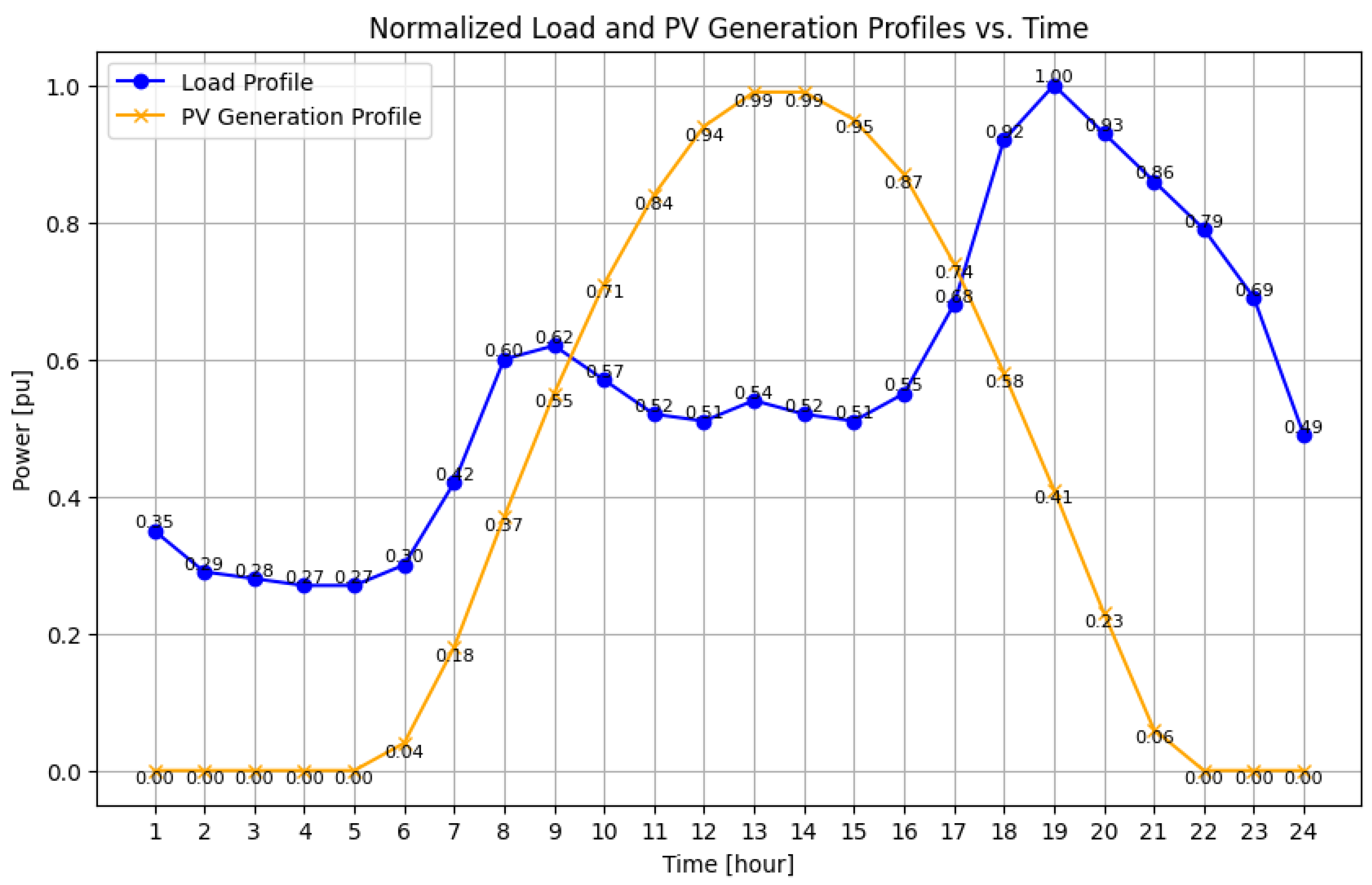
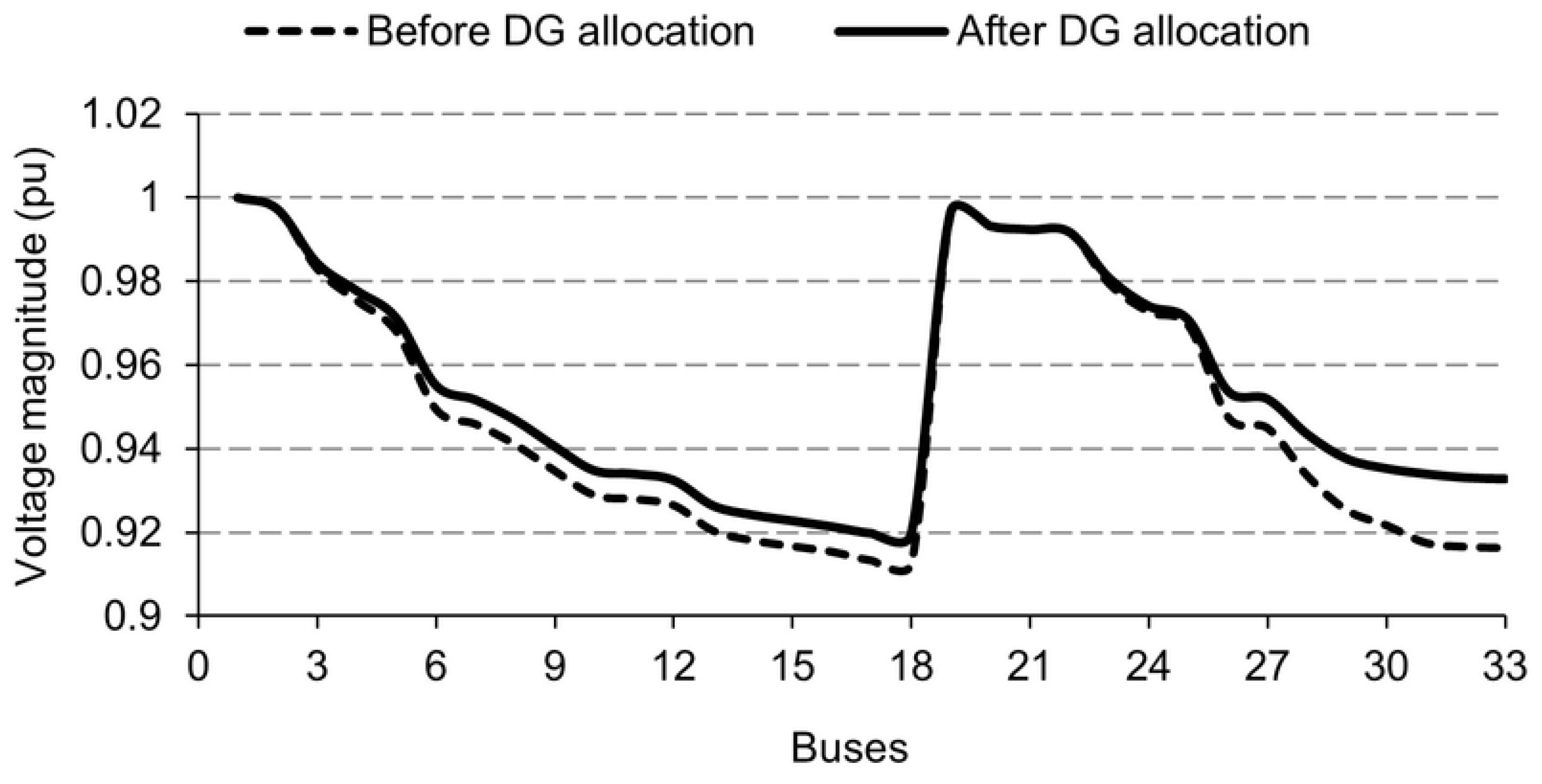

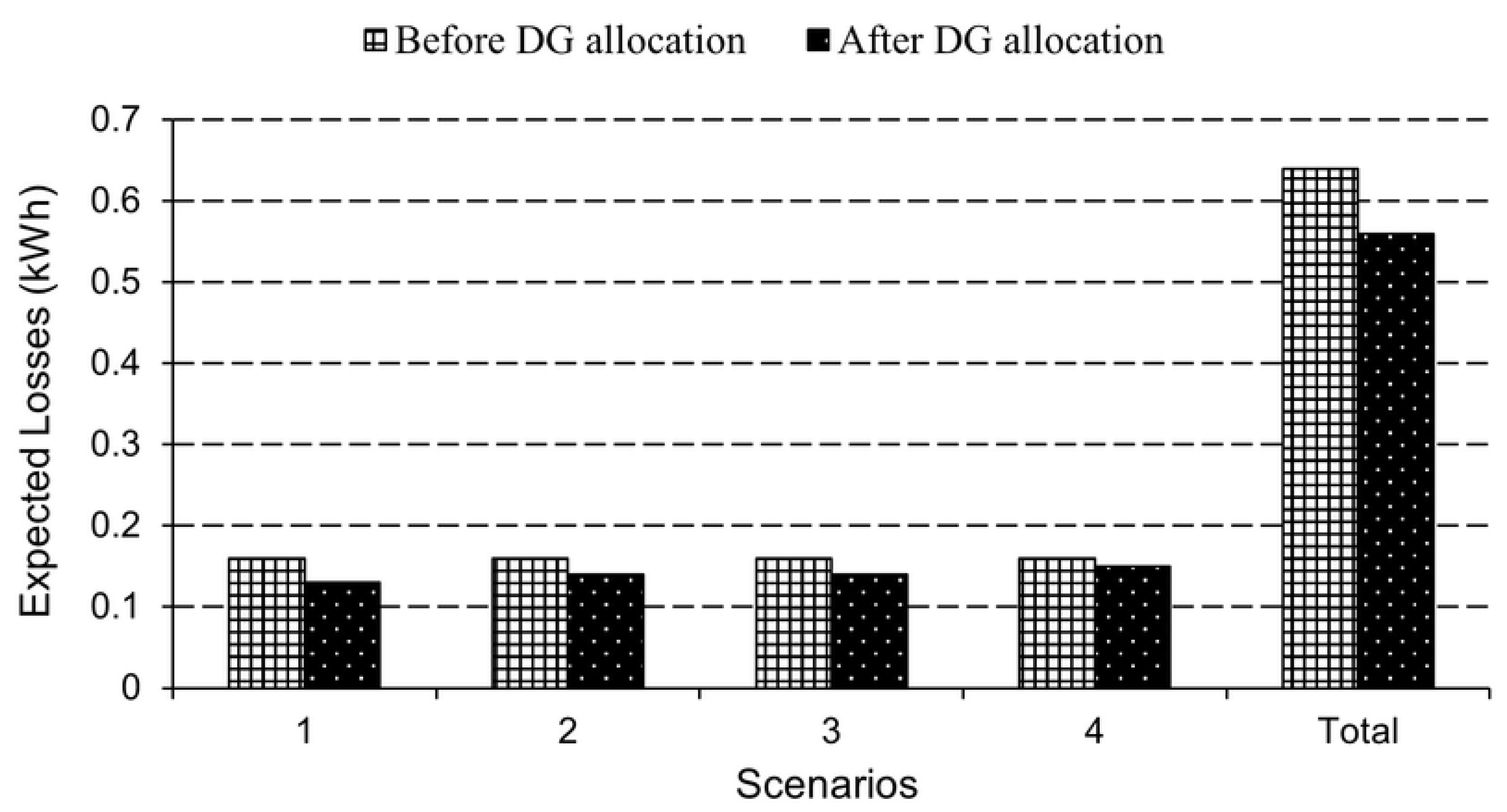

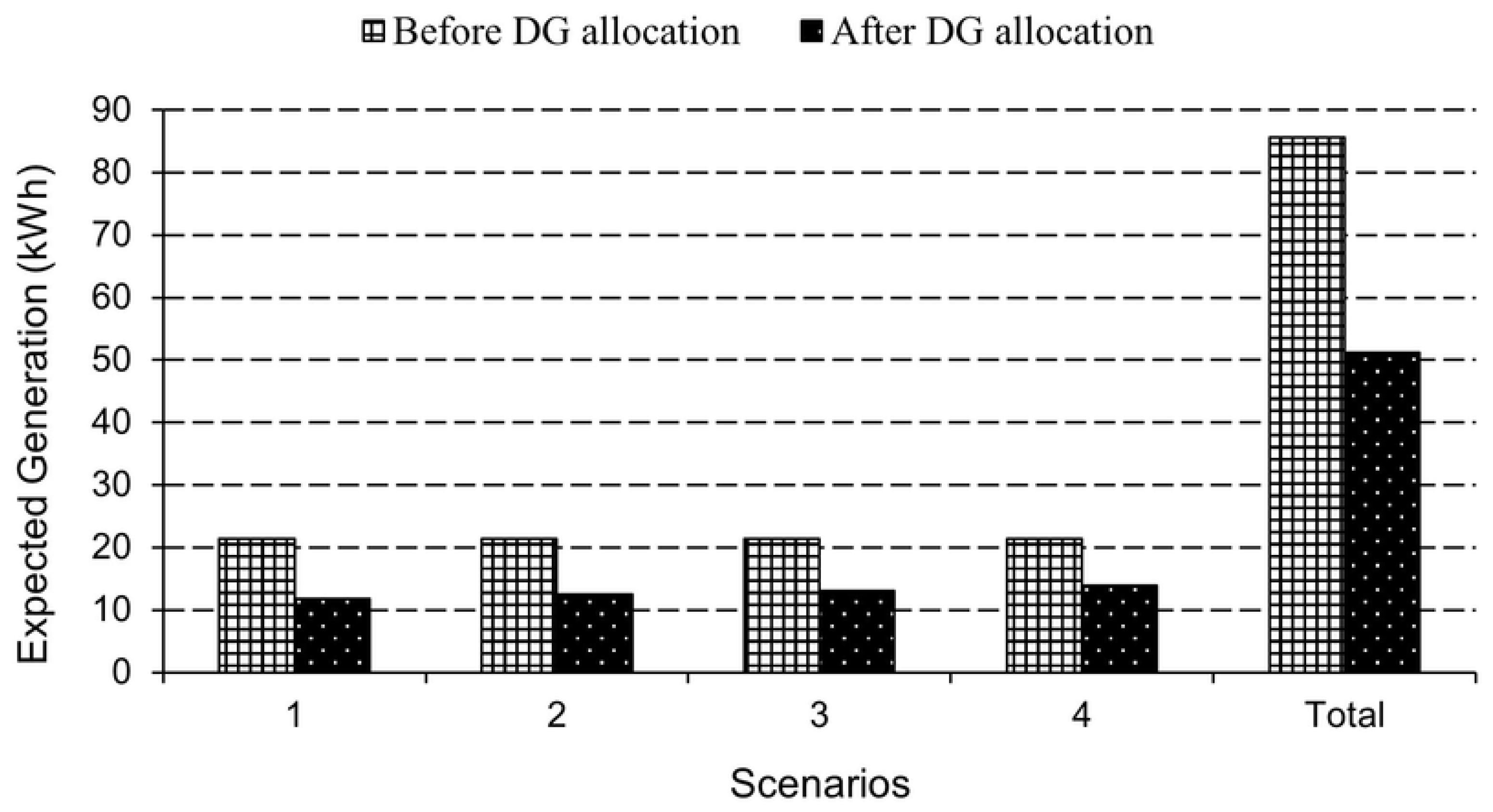
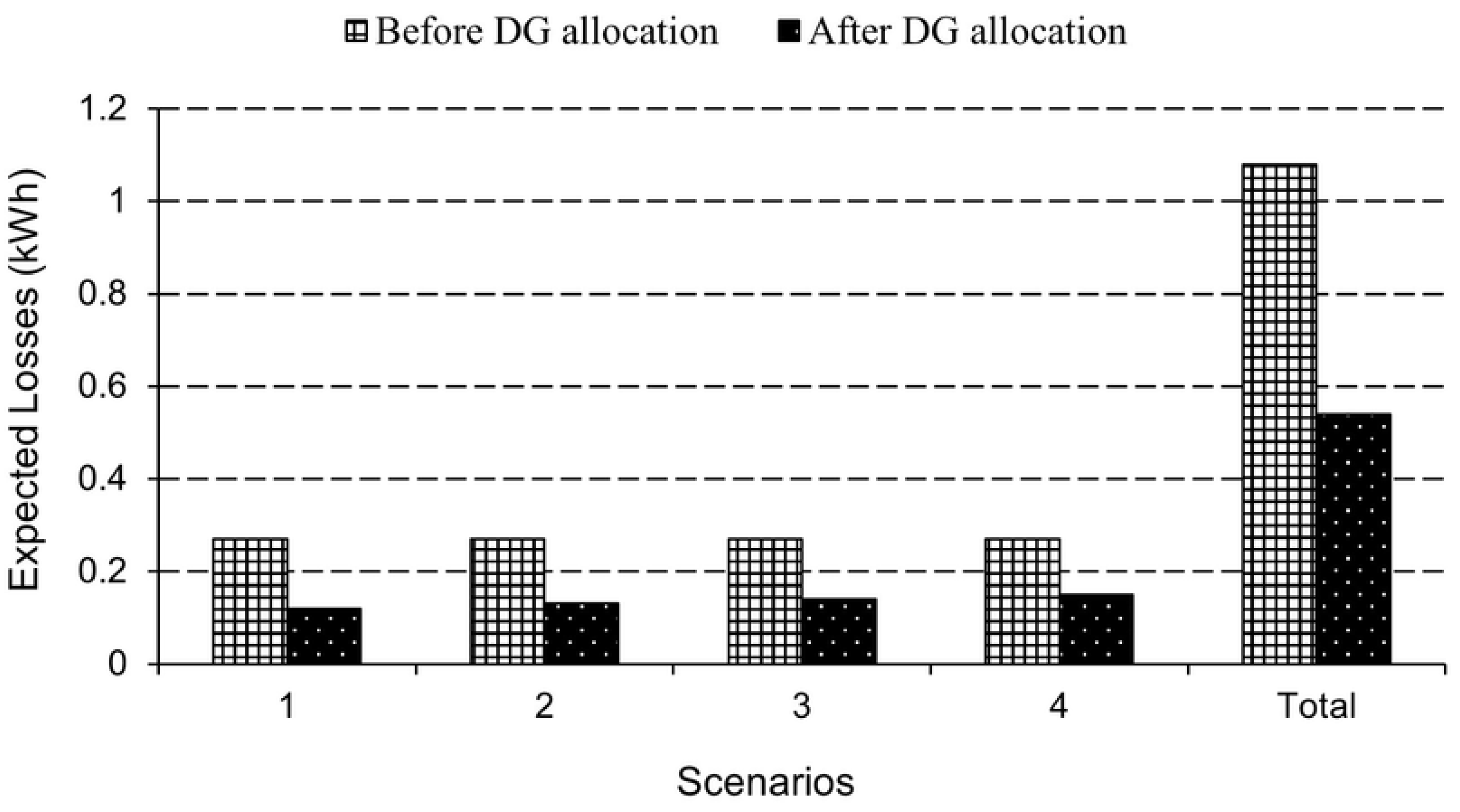
| Type | Maximum Active Power (kW) | Investment Cost ($/kW) | Installation Cost ($/kW-yr) | Energy Cost ($/kWh) |
|---|---|---|---|---|
| 1 | 100 | 3510 | 357.50 | 0.0022 |
| 2 | 500 | 2650 | 269.90 | 0.0022 |
| 3 | 1000 | 2040 | 207.78 | 0.0018 |
| Bus | Number | Generation in Every Scenario (kWh) | |||||
|---|---|---|---|---|---|---|---|
| Type 1 | Type 2 | Type 3 | t = 1 | t = 2 | t = 3 | t = 4 | |
| 18 | 2 | 0 | 0 | 0.13943 | 0.10161 | 0.06671 | 0.02271 |
| 31 | 0 | 0 | 1 | 0.69624 | 0.50703 | 0.33323 | 0.11292 |
| 32 | 0 | 1 | 0 | 0.34842 | 0.25382 | 0.16662 | 0.05651 |
| 33 | 1 | 0 | 0 | 0.07001 | 0.05101 | 0.03342 | 0.01142 |
| Before DG Allocation | After DG Allocation | |
|---|---|---|
| IC | 0 | 449,980.3 |
| 0 | 4696.73 | |
| 17,044,786.84 | 16,268,149.95 | |
| 17,044,786.84 | 16,722,826.98 |
| Bus | Number | Generation in Every Scenario (kWh) | |||||
|---|---|---|---|---|---|---|---|
| Type 1 | Type 2 | Type 3 | t = 1 | t = 2 | t = 3 | t = 4 | |
| 12 | 0 | 1 | 0 | 4723.9 | 3439.8 | 2259.5 | 766.1 |
| 18 | 0 | 1 | 0 | 4723.8 | 3439.7 | 2259.5 | 766.1 |
| 35 | 0 | 1 | 0 | 4722.9 | 3439 | 2259.5 | 766.1 |
| 45 | 0 | 1 | 0 | 4722.1 | 3438.4 | 2259.5 | 766.1 |
| 49 | 0 | 1 | 0 | 4145.2 | 3237.8 | 2259.5 | 766.1 |
| 56 | 0 | 1 | 0 | 4709.1 | 3434.8 | 2259.5 | 766.1 |
| 68 | 0 | 1 | 0 | 4675 | 3432.8 | 2259.5 | 766.1 |
| 83 | 0 | 1 | 0 | 4723.5 | 3439.5 | 2259.5 | 766.1 |
| 121 | 0 | 1 | 0 | 4564.7 | 3407.6 | 2259.5 | 766.1 |
| 128 | 0 | 1 | 0 | 4724 | 3440.1 | 2259.5 | 766.1 |
| 134 | 0 | 2 | 0 | 9425.4 | 6869.7 | 4518.4 | 1531.6 |
| 141 | 0 | 1 | 0 | 4721.4 | 3438.2 | 2259.5 | 766.1 |
| 155 | 0 | 2 | 0 | 9444.4 | 6878.8 | 4518.4 | 1531.6 |
| 158 | 0 | 1 | 0 | 4697 | 3438 | 2259.5 | 766.1 |
| 203 | 1 | 0 | 0 | 945.5 | 688.6 | 452.3 | 153.7 |
| 217 | 0 | 1 | 0 | 4715.1 | 3434.6 | 2259.5 | 766.1 |
| 221 | 0 | 1 | 0 | 4706.6 | 3433.5 | 2259.5 | 766.1 |
| Before DG Allocation | After DG Allocation | |
|---|---|---|
| IC | 0.00 | 2,464,850.10 |
| 0.00 | 40,649.46 | |
| 82,115,395.00 | 49,041,739.00 | |
| 82,115,395.00 | 51,547,238.57 |
Disclaimer/Publisher’s Note: The statements, opinions and data contained in all publications are solely those of the individual author(s) and contributor(s) and not of MDPI and/or the editor(s). MDPI and/or the editor(s) disclaim responsibility for any injury to people or property resulting from any ideas, methods, instructions or products referred to in the content. |
© 2023 by the authors. Licensee MDPI, Basel, Switzerland. This article is an open access article distributed under the terms and conditions of the Creative Commons Attribution (CC BY) license (https://creativecommons.org/licenses/by/4.0/).
Share and Cite
Kheirkhah, A.R.; Meschini Almeida, C.F.; Kagan, N.; Leite, J.B. Optimal Probabilistic Allocation of Photovoltaic Distributed Generation: Proposing a Scenario-Based Stochastic Programming Model. Energies 2023, 16, 7261. https://doi.org/10.3390/en16217261
Kheirkhah AR, Meschini Almeida CF, Kagan N, Leite JB. Optimal Probabilistic Allocation of Photovoltaic Distributed Generation: Proposing a Scenario-Based Stochastic Programming Model. Energies. 2023; 16(21):7261. https://doi.org/10.3390/en16217261
Chicago/Turabian StyleKheirkhah, Ali Reza, Carlos Frederico Meschini Almeida, Nelson Kagan, and Jonatas Boas Leite. 2023. "Optimal Probabilistic Allocation of Photovoltaic Distributed Generation: Proposing a Scenario-Based Stochastic Programming Model" Energies 16, no. 21: 7261. https://doi.org/10.3390/en16217261
APA StyleKheirkhah, A. R., Meschini Almeida, C. F., Kagan, N., & Leite, J. B. (2023). Optimal Probabilistic Allocation of Photovoltaic Distributed Generation: Proposing a Scenario-Based Stochastic Programming Model. Energies, 16(21), 7261. https://doi.org/10.3390/en16217261









